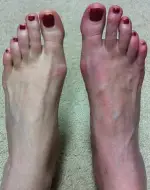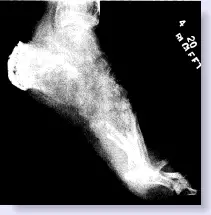Complex Regional Pain Syndrome (CRPS)
AUTHOR: Marc Mitnick DPM home --> CRPS-complex regional pain syndromeReflex Sympathetic Dystrophy (RSD), Causalgia, Sudeck's Atrophy
WHAT IS COMPLEX REGIONAL PAIN SYNDROME
Complex Regional Pain Syndrome (CRPS) is a poorly understood neurological phenomenon that is even more confusing because it goes by so many different names. It is also known as Reflex Sympathetic Dystrophy (RSD), Sudecks Atrophy and causalgia.
The condition is basically a short circuit of the nervous system where nerves misfire thus sending constant pain signals to the brain even though there is no real or limited pain going on. In other words, it is a completely abnormal response by the nervous system to external stimuli.
CRPS can occur anywhere on the body but is fairly common in the foot and leg. Pain is out of proportion to an injury; the pain may be severe, constant or burning. There may be a hypersensitivity to external stimuli like heat or cold.
three stages of complex regional pain syndrome
There are three stages in this condition, although most people do not necessarily have to go through all of the stages.
Stage 1 the traumatic stage, starts immediately or several weeks after injury. Keep in mind that surgery to the foot or leg can be considered trauma. The skin becomes dry, and red which then becomes cool and moist within several weeks. The foot and lower leg will begin to swell. There will be limitation of joint movement and constant pain only alleviated by sleep and pain medication. osteoporosis
may start at this stage in some cases.
Stage 2 begins about 2-6 months after the injury. The skin becomes further moist, tight and shiny. The nails of the foot will become brittle and cracked. The patient will be walking in a guarded gait because the joint of the foot and ankle will locked.
Stage 3 occurs 6-9 months after the injury. This stage is characterized by irreversible structural changes, notably soft tissue atrophy (wasting) and decalcification of bone. Pain gets worse and may spread beyond the original site. The pain is often intractable. The skin at this point is cool and dry.
Look at the picture of the feet below. Note the increased redness in the right foot. This patient had undergone surgery on the right foot, had been in a cast, and CRPS developed afterwards.

|
The following x-ray reveals the severe osteoporosis
that can occur. Look how demineralized the middle of the foot appears.

|
There are two types of CRPS, Type I and Type II. Type I is also referred to RSD and these involve cases in which the nerve injury cannot immediately be identified. Type II also referred to as Causalgia involves cases where there has been a major trauma to a distinct nerve.
TREATMENT FOR COMPLEX REGIONAL PAIN SYNDROME
There really is no laboratory test to diagnose Complex Regional Pain Syndrome. It is diagnosed on clinical grounds particularly to a nerve or soft tissue injury which does not respond in a normal healing path.
A thorough medical history and physical examination are necessary. It should be noted that in this instance surgery can be considered as an injury. CRPS has been seen quite frequently following elective foot surgery where the foot and lower leg required immobilization for a period of time due to the type of surgery performed.
It is estimated that people go to as many as five doctors before the proper diagnosis is made. The problem with this is that valuable time is wasted in beginning treatment. The earlier treatment is instituted , the better the prognosis.
There are basically three types of specialists that are the most likely to make a proper diagnosis and they should be consulted for treatment.
- neurologist
- physiatrist
- anesthesiologist who specializes in pain management
Even going to one of these specialists does not guarantee proper diagnosis and treatment. You should ask your physician if he or she is experienced in treating this condition.
Treatment, of course, is based on the severity of the presenting symptoms. Treatment options includes:
- Peripheral nerve blocks- may be performed in an effort to break up the ongoing pain sensation being transmitted to the brain.
- A TENS unit- is sometimes of value in an effort to break the pain cycle.
- Physical therapy- including massage, compression, and range of motion exercises to the affected areas.
- nonsteroidal anti-inflammatory medication- may be used for pain and inflammation.
- Systemic therapy with oral steroids, gabapentin, propranolol, nifedipine or other mood altering drugs may be helpful.
- Surgical lumbar sympathectomy in very severe cases, may be performed as a means to break the pain cycle.
living with complex regional pain syndrome
The points to take away from this discussion of Complex Regional Pain Syndrome is that it is a diagnosis that is often overlooked and because of the delay in treatment, or even under treatment, permanent pain and disability may arise. Additionally there are only a few types of specialists that are properly experienced to adequately treat this condition.
REFERENCES
Want more information? CLICK HERE


Recent Articles
-
Vitamin D impact on health
Feb 06, 23 07:17 PM
Researchers are suggesting that the effectiveness of Vitamin D in fighting and preventing disease is predicated on a persons body mass index (BMI). The thinner the person the greater the positive impa… -
Foods to speed up healing
Feb 01, 23 02:41 PM
One of the best ways to help yourself heal faster after surgery is to eat well. Getting the proper nutrition will provide your body with the essentials it needs to promote healing. Here is a suggestio… -
Cancer and Type 2 Diabetes
Jan 25, 23 04:52 PM
An article revealing that older type 2 diabetics have a higher incidence of cancer then non-diabetics. It is suggested that cancer may surpass CVD as the number one cause of death in older diabetics. -
Does glucosamine or MSM reduce arthritis pain?
Jan 22, 23 01:41 PM
A good review of the possible benefits to taking glucosamine, chondroitin or MSM for arthritis. Always beware of the possible side effects of over the counter supplements. -
shin splints
Jan 18, 23 05:12 PM
A great review on the various causes of shin splints, along with treatment options. -
Whats new in skin cancer?
Jan 15, 23 08:32 PM
A presentation of newer skin protection combinations in an effort to better protect the skin from the hazards of sun exposure. -
Causes and risk factors of warts
Jan 14, 23 05:02 PM
A good review of the causes of warts and protective measures you can take to prevent developing them. -
Do chronic wounds need to be dressed daily?
Jan 11, 23 02:18 PM
Because of supply chain shortages as well as staffing shortages particularly during the pandemic, many institutions extended the time between dressing changes for chronic wounds. Is this really the be… -
Food choices that raise your risk of type 2 diabetes
Jan 08, 23 10:07 AM
A good review of how blood sugars can become elevated and the harm that can do. Certain food groups have a tendency to raise your blood sugars and should be avoided. -
Outcome stats from Scarf bunionectomy
Jan 03, 23 03:04 PM
The Journal of Foot and Ankle Surgery recently reported a meta analysis of outcomes in 1583 Scarf bunionectomies that met their inclusion criteria. Adverse events did not seem to be any better or wors…